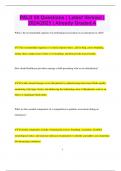Exam (elaborations)
PALS 50 Questions | Latest Version | 2024/2025 | Already Graded A
- Course
- Institution
PALS 50 Questions | Latest Version | 2024/2025 | Already Graded A What is the recommended sequence for performing resuscitation on an unresponsive child? The recommended sequence is to check responsiveness, call for help, assess breathing, initiate chest compressions if there is no breathi...
[Show more]



